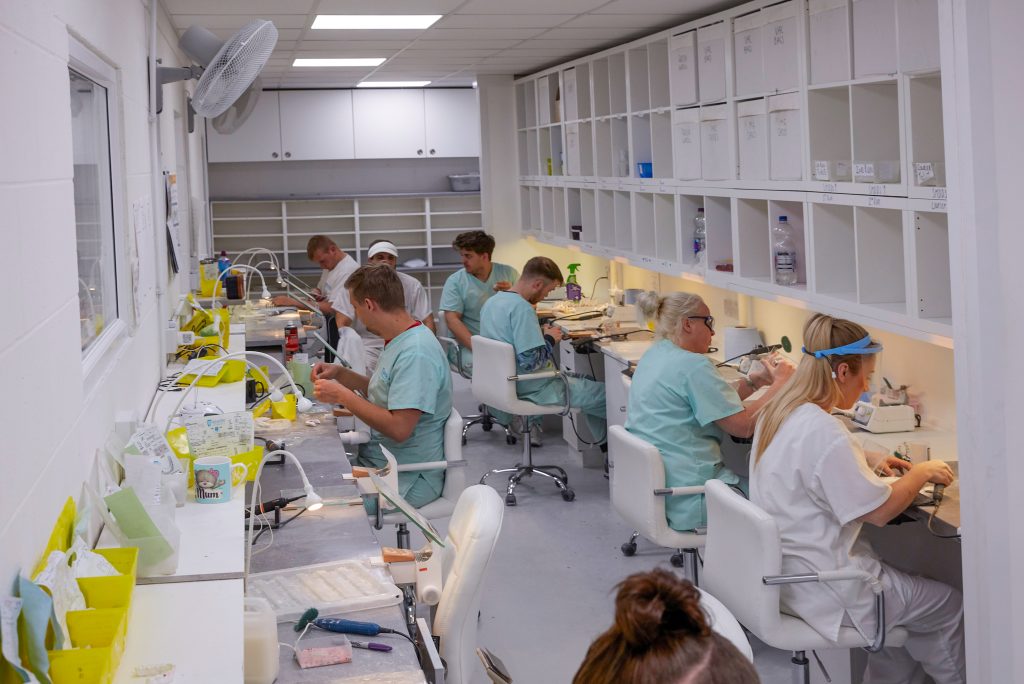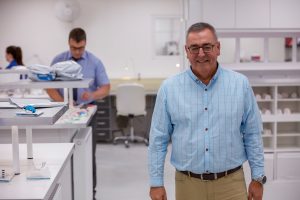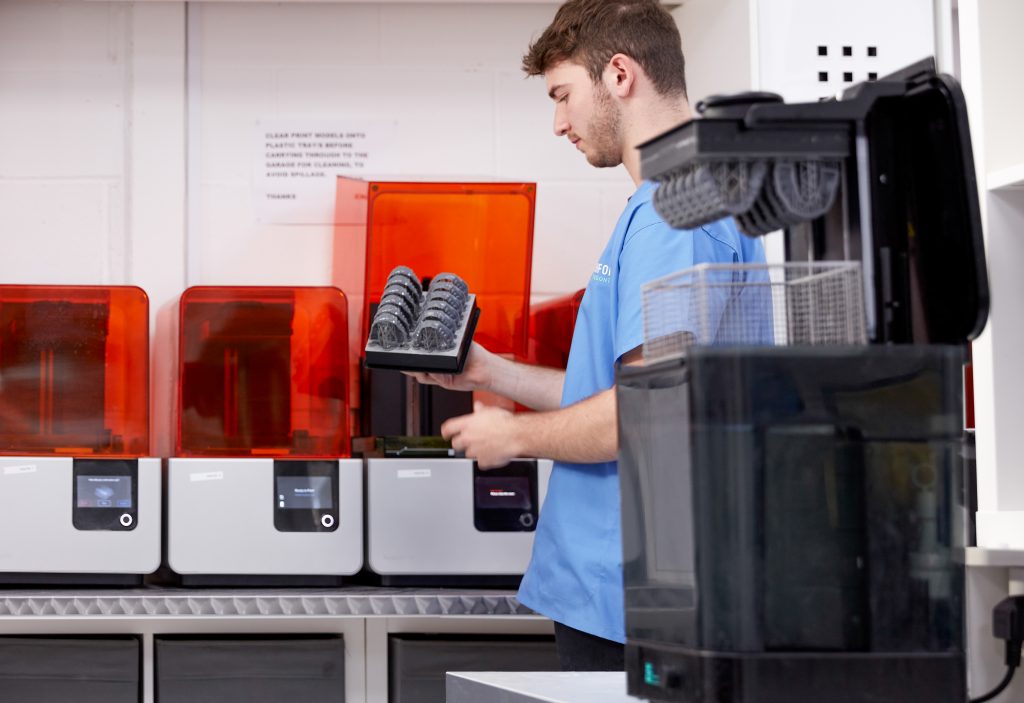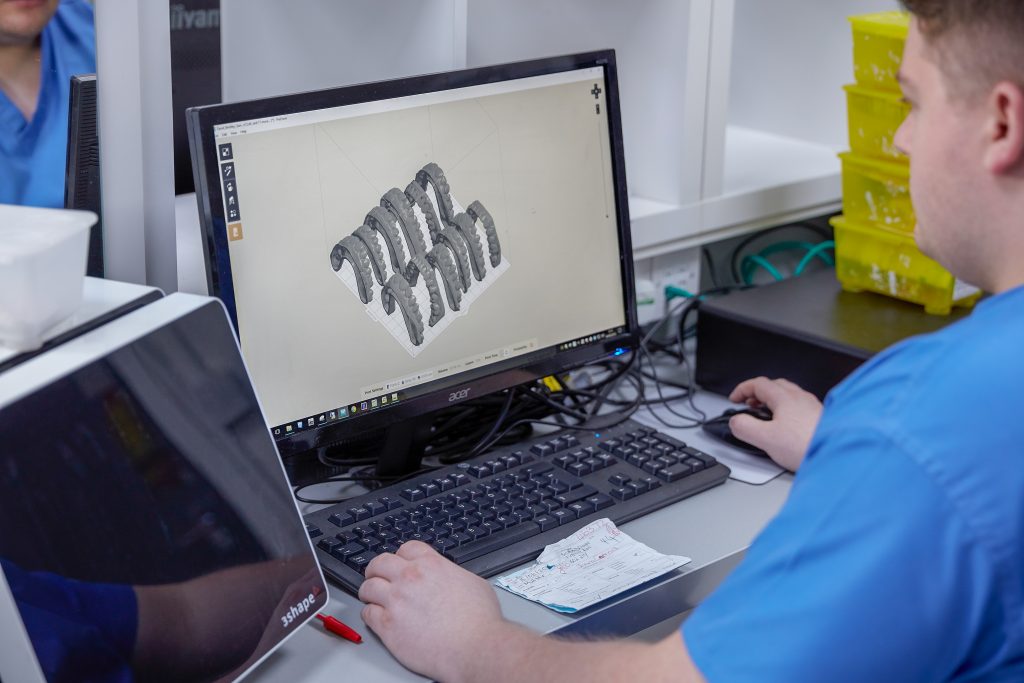The largest orthodontic laboratory in the United Kingdom is Ashford Orthodontics, which was founded in 2001 by Sean Thompson in his garage after several years working in the Orthodontic and Maxillofacial Department at Sunderland Royal Hospital. Thompson started the company after noting that there was a growing demand for orthodontic devices but a shortage of high quality laboratories offering specialized orthodontic technical services. His business quickly grew, and he was joined by fellow orthodontic technicians Craig Stevens and Graeme Winyard. Now the lab is 12,000 square feet and has more than 50 employees.
Five years ago, Ashford Orthodontics started looking into digital orthodontic practices.
“Digital orthodontics was something we knew we had to get into,” said Thompson. “We couldn’t afford not to do it if we really wanted to be a leading player within orthodontics. We wanted to be an early implementer. Any business has to plan four or five years ahead, and you don’t want to be left behind when others are moving on.”
The company then bought a Formlabs Form 2. They started off with one of the printers, and are now up to 12.
There are now eight digital technologists in the company’s digital department, managing the 12 Form 2 3D printers.
“The Form 2 is very reliable; we call it a workhorse,” Thompson continued. “We know when we go home at night that when we come in in the morning, everything will be printed. There’s not going to be a failure; everything will be there. Because of that, we can build our business around them.”
Every day, the lab has a working cutoff time of about 3:00 PM. The technicians review new scans sent in by clients, then plan out treatments and set the necessary parts, such as aligners, to 3D print overnight. In the morning, a technician cleans and dries the 3D printed parts, after which another technician thermoforms the clear aligners on the finished models. By the time most of the other technicians arrive, the aligners are ready for post-processing.
“Once you’ve got a model to work on, there’s very little difference,” said Thompson. “If you are a traditional lab and you want to go and push the boundaries to digital, once you’ve done the learning side of it, the manufacturing side is pretty similar.”
In the afternoon, the finished aligners are packaged and sent to the clinicians, arriving within 48 hours.
“It works absolutely perfect for us,” said Thompson. “We launch the printers just before we go home at night; that’s our night shift. We come in the next morning and by then, the night shift has done their job. It doesn’t matter if they’re sitting there for two hours, four hours, six hours—it’s done. We totally rely on that coming in on the morning, so it’s the quality and reliability of the print that matters to us.”
Having multiple 3D printers helps, as does their large build platforms.
“It’s quite easy for us just spread a few models along 10 or 12 printers and have them printed in a couple of hours. So if we do need to do quick runs, we can accommodate them across all the printers instead of putting them all on one. We find that that works very well for our business.”
The lab can also store digital models online and access them at any time, which is helpful when things like retainers need to be replaced.
“There’s no time lapse due to a child breaking or losing their retainer and having to go to the dentist to get a new impression,” said Thompson. “Teeth are drifting all the time and relapse is happening. We can just pull the file from the cloud—where we store them basically for free—print the model, create the appliance, and even send it directly to the patient.”
The lab can also reuse the same 3D model to create multiple appliances if necessary.
“A common trend now is to debond the brackets and instantly fit all the retention products chairside,” Thompson said. “By removing the brackets digitally, we can make an Essix, bonded, or a Hawley retainer, and a whitening tray all on the same model which simply isn’t possible via the traditional route and plaster models.”
Ashford Orthodontics has been able to pass on cost and time savings to their clients by going digital.
“It shouldn’t cost you any more to provide your services to your clients and patients via the digital route than via the traditional impression route,” said Thompson. “So what we’ve done is quite simply that we swapped the cost of the plaster models—which aren’t needed anymore—with the cost of the resin model. Therefore, your lab bill is exactly the same, whether it’s done via the traditional route or the digital route, except you can have things back 24 hours sooner.”
The company has become a trusted provider that attracts customers from the UK as well as all over the world.
“We’ve got new clients coming to us every day, who have never used us before, so they don’t know if the quality is going to be good or if the customer service is going to be reliable,” said Thompson. “When they realize that what we’re providing here is very good quality, they trust us to send us the more complex appliances. So invariably, within two months of getting a new client who wants to use our services for digital orthodontics, they start asking if we can do twin blocks, fixed appliances, or functionals. Before we know it, they’re sending us lots and lots of work, because we can accommodate all of their needs.”
Ashford now provides digital services to three practices that have no impression materials in their offices – they’ve gone fully digital, thanks to the services of the lab.
“When we first started with the digital side of things, it accounted for maybe two percent of our business,” said Thompson. “Just this last month it’s around 15 percent, and it is the fastest growing sector within the laboratory. “At the moment, it’s traditional techniques with a little bit of digital, but in a matter of two or three years, it’s going to be digital techniques with a little bit of traditional. And that’s going to be the driving force for our department moving forward.”
Discuss this and other 3D printing topics at 3DPrintBoard.com or share your thoughts below.
[Images: Formlabs]
Subscribe to Our Email Newsletter
Stay up-to-date on all the latest news from the 3D printing industry and receive information and offers from third party vendors.
You May Also Like
Meet Xell, xolo’s Budget-Friendly Bioprinter for Labs
Building on its expertise in volumetric bioprinting, xolo has unveiled Xell. This compact bioprinter brings rapid fabrication of complex structures without visible layers to research labs at an unprecedented price....
Axolotl Biosciences Brings Biotech to the Forefront at Formnext 2024
Formnext 2024 is known as the world’s leading trade fair for industrial 3D printing, with towering machines and manufacturing giants filling its halls. Amid this industrial frenzy, Axolotl Biosciences, a...
BICO’s €26M Nanoscribe Sale Highlights Strategic Overhaul Under Forss
BICO (STO: BICO) announced its second divestiture since Maria Forss took over as President and CEO in November 2023. Following the sale of Ginolis last year, BICO has now entered...
3D Systems Pushes New Tech and Partnerships at Formnext
As one of the pioneering companies in additive manufacturing (AM), 3D Systems remains a key player to watch at Formnext 2024, where it is showcasing major partnerships, innovative technologies, and...








































